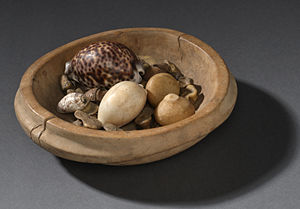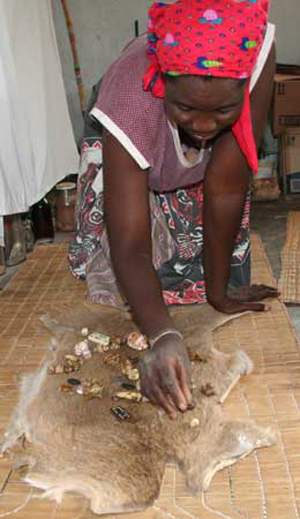Category:Throwing the Bones and Reading Other Natural Curios
From Association of Independent Readers and Rootworkers
| |||||
In the traditions of some cultures, the bones, shells, and/or nuts that are to be thrown are left in their natural state; in other cultures they may be shaped and marked, much like dice, dominoes, or the cut cowrie shells used in Obi and Diloggun divination.
Marked bones are often used in groups of two or four to obtain yes or no answers, as well as more detailed information. There is quite a bit of evidence to support the idea that gaming dice, often casually called "the bones," may have had their origin in marked bone divination, as there are still forms of divination in which the markings of the spots and dots on dice or dominoes are used to read fortunes for clients.
Among the Zulu sangoma diviners of South Africa, it is common to use a large set of bones and other natural curios, such as the eighteen items shown in the wooden bowl here.
Among the Mongolians, four unmarked sheep astragalus or knuckle bones are thrown, each of which has four distinguishable sides, which produces an array of 36 possible answers to any given question. The name for this system of divination is shagai, often rendered in English as "Complicated Fortune Telling." In addition to functioning as a system of divination, shagai can also be played as a gambling game.
Bone Readings
In bone divination, bones of various sorts are ritually tossed onto a mat, an animal hide, or into a circle drawn in the dirt, and the resulting patterns interpreted. Throwing the bones is an ancient practice traditional to many regions of the world, including Africa, Asia, and North America. The number and type of bones employed, as well as the inclusion of other small objects, such as pebbles, shells, and hard nuts, varies quite a bit from culture to culture.
As a hoodoo practice, casting or throwing the bones has deep traditional roots in African culture, especially as developed among the sangomas or divining healers of the Zulu, Swazi, Xhosa, and Ndebele traditions in southern Africa. Trained as herbalists, spirit mediums, and diviners, they fulfill an important role in their culture, equivalent to that of a root doctor in the United States or an obeah practitioner in Jamaica.
Mingling of African traditions with Native American and European forms of divination have produced quite a lot of variation in hoodoo practices. Traditional items used by Southern-style hoodoo doctors and spirit-led fortune tellers who employ these ancient methods of divination include bones, stones, coins, stalks, or shells. Additionally, some who follow this style of divining with natural curios may also perform augury by inspection of natural botanical and zoological curios such as ow


No comments:
Post a Comment